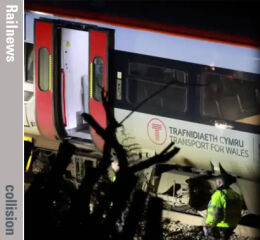Posted 30th April 2025
Train in fatal Welsh head-on collision had various sander faults

The Rail Accident Investigation Branch has confirmed that there were two blocked sander hoses on a Class 158 unit involved in a fatal head-on collision in mid-Wales last year.
A train heading west failed to stop within a passing loop at Talerddig on 21 October, ran through the points at the far end and collided with an oncoming train.
There were 31 people on board the westbound train, including the driver, guard and another member of railway staff. One passenger died and three other people were seriously hurt, including the guard. The driver of the eastbound train was also seriously injured, and became trapped in the cab.
The driver of the westbound train had made an emergency brake application without success, and managed to warn passengers that a collision was imminent.
When the westbound train overran the points at the far end of the loop it was on a descending gradient, and the collision occurred at a combined speed of 50 km/h (30 mph), damaging both units as well as causing the casualties. The eastbound train was pushed back about 35 metres by the impact.
Weather forecasters had warned that rail adhesion in the Talerddig area was likely to be ‘moderate or poor’ on the day in question, because 3 to 4 per cent of the season’s leaves were likely to be on the ground and more were expected to fall during the day because of high winds associated with Storm Ashley.
The unit with the faulty sanders should have been stabled at Crewe depot overnight, but because some services had been disrupted it actually spent the night in a platform at Chester. This meant that the driver could not reach equipment on the train’s underframe at the start of duty, and the sander test button could not be checked.
As well as the blocked sander hoses, an electrical fault had also prevented the automatic sander from working, while the orifice plates, which are part of the sander pneumatic system, were found to have been installed incorrectly. However, it is not clear whether electrical faults had been caused by the collision, or occurred when the trains were being removed from the collision site.
The report is an interim one, and the RAIB’s investigation is continuing.
Do you have a comment on this story? Please click here to send an email to Platform at Railnews.
Moderated comments will be published on this site, and may also be used in the next print edition.
